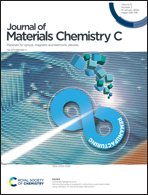Two-dimensional metal–organic nanosheets composed of single-molecule magnets: structural modulation and enhanced magnetism utilizing the steric hindrance effect†
Abstract
Two-dimensional arrays of single-molecule magnets (SMMs) are a prerequisite for the construction of devices with ultrahigh-density magnetic memory based on molecular spintronics. The advantage of using such molecules in inorganic-based materials is the facile tuning of the accumulated structures and the resultant magnetic properties upon chemical modifications. In this study, we report the systematic modification of two-dimensional SMM-based metal–organic framework (MOF) structures via Langmuir–Blodgett methods and the chemical modifications of SMMs. A series of phthalocyaninato–porphyrinato terbium(III) double-decker SMMs substituted by four pyridyl units of the porphyrinato unit and alkoxyl chains of different lengths on the phthalocyaninato unit were synthesised and reacted with Pd2+ ions at the air–water interface to obtain the two-dimensional SMM-based MOFs. The MOFs exhibit perpendicular magnetic anisotropy, a promising aspect for the application of information storage. X-ray structural and surface pressure analyses revealed that the introduction of bulky alkoxide groups induced structural changes from densely to loosely packed structures. Furthermore, the magnetic structure of the thin film formed on water changed from in-plane to perpendicular magnetic anisotropy by increasing the alkoxide chain length. Our results suggest that the structure and magnetism of the thin films can be systematically modulated by introducing appropriate substituents. Our strategy for making SMM nanosheets is promising compared to previous methods from the viewpoint of the high concentration of SMMs, structural regularity, designability, and controlling the molecular arrangements based on molecular modification and solution-based processes.



 Please wait while we load your content...
Please wait while we load your content...